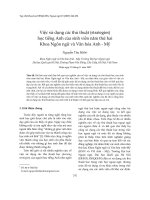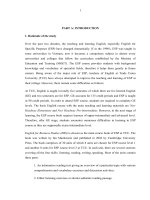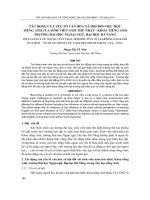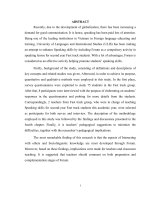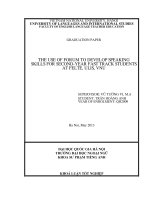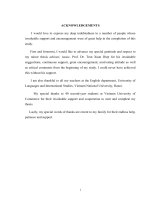Nghiên cứu việc sử dụng các hoạt động nhóm để nâng cao kỹ năng viết đoạn văn tiếng Anh cho sinh viên năm thứ hai trường Cao đẳng Y tế Thái Nguyên
Bạn đang xem bản rút gọn của tài liệu. Xem và tải ngay bản đầy đủ của tài liệu tại đây (1.33 MB, 66 trang )
VIETNAM NATIONAL UNIVERSITY, HANOI
UNIVERSITY OF LANGUAGES AND INTERNATIONAL STUDIES
FACULTY OF GRADUATE STUDIES
*********************
VŨ THỊ HÒA
IMPROVING ENGLISH PARAGRAPH- WRITING PERFORMANCE BY THE
SECOND- YEAR STUDENTS AT THAI NGUYEN MEDICAL COLLEGE
THROUGH COLLABORATIVE WRITING ACTIVITIES
Nghiên cứu việc sử dụng các hoạt động nhóm để nâng cao kỹ năng viết đoạn văn
tiếng Anh cho sinh viên năm thứ hai trường Cao đẳng Y tế Thái Nguyên
M.A MINOR PROGRAMME THESIS
FIELD: ENGLISH TEACHING METHODOLOGY
CODE: 60140111
Hanoi, 2014
VIETNAM NATIONAL UNIVERSITY, HANOI
UNIVERSITY OF LANGUAGES AND INTERNATIONAL STUDIES
FACULTY OF GRADUATE STUDIES
*********************
VŨ THỊ HÒA
IMPROVING ENGLISH PARAGRAPH- WRITING PERFORMANCE BY THE
SECOND- YEAR STUDENTS AT THAI NGUYEN MEDICAL COLLEGE
THROUGH COLLABORATIVE WRITING ACTIVITIES
Nghiên cứu việc sử dụng các hoạt động nhóm để nâng cao kỹ năng viết đoạn văn
tiếng Anh cho sinh viên năm thứ hai trường Cao đẳng Y tế Thái Nguyên
M.A MINOR PROGRAMME THESIS
FIELD: ENGLISH TEACHING METHODOLOGY
CODE: 60140111
SUPERVISOR: PROF. NGUYỄN HÒA
Hanoi, 2014
i
DECLARATION
I certify that this thesis is the result of my own research and that this thesis has not been
submitted for a degree to any other university or institution wholly or partially.
Signature
Vu Thi Hoa
ii
ACKNOWLEDGEMENTS
I would like to express my gratitude to all those who have given me great assistance,
encouragement and support in the completion of my research work.
First and foremost, I would like to express my profound gratitude and appreciation to my
supervisor, Prof. Nguyen Hoa for his invaluable and insightful comments, his deliberate
guidance and wholehearted supervision during the study.
My thanks are also offered to all my respected lecturers in the Faculty of Post Graduate
Studies, ULIS, VNU, Hanoi for their informative, valuable lectures and suggestions that
have enlightened my research path of the study.
I am also grateful to all my colleagues and students at TMC for their enthusiastic
participants in my research.
Last but not least, I would like to show my big gratitude to my family, my relatives,
especially my husband who encourage and help me to carry out the study.
Hanoi, August 2014
iii
ABSTRACT
The study has been conducted for the purpose of enhancing the effectiveness through the
application of collaborative writing activities to improve the second- year students at TMC
in writing skills. Participants are 40 second- year- students from the Department of
Midwifery and Nursing at TMC divided into two groups: experimental group and control
group. The experimental group is taught in collaborative learning for eight weeks. The
control group is taught in the traditional method of the teacher- centered approach.
Findings from pre- and post tests, pre and post- questionnaires reveals that: i) Collaborative
writing activities have improved students’ proficiency in writing skills; ii) the method has
positive effects on student’s attitudes and opinions toward writing; iii) the study provides
more information concerning the implementation of collaborative writing.
It is hope that the thesis will make some contribution to the improvement of learning and
teaching writing skill based on collaborative activities. These activities help students feel
confident to write paragraph writings. Moreover, they have more opportunities, are more
comfortable and more interested in collaborative activities.
iv
LIST OF ABBREVIATIONS
CWA: Collaborative Writing Activities
TMC: Thai Nguyen Medical College
CL: Collaborative Learning
v
LIST OF TABLES AND FIGURES
Table 1: Checklists of writing tasks in Lifelines- Elementary
Table 2: Students’ view on writing lesson before and after the experiment
Table 3: The difficulties of students on writing lesson before and after the
experiment
Table 4: Students’ opinions about the way they like to do writing in class
Table 5: Students’ opinions of writing in English
Table 6: Students’ opinions on collaborative writing activities
Figure 1: Stages of the process approach to writing
Figure 2: Pre- test results of both groups
Figure 3: Post- test results of both groups
Figure 4: Pre and post test results of the experimental group
vi
TABLE OF CONTENTS
Acknowledgements...............................................................................................................ii
Abstract .............................................................................................................................. iii
Table of contents ................................................................................................................ iv
List of abbreviations ...........................................................................................................vi
List of tables and figures....................................................................................................vii
PART A: INTRODUCTION
1. Rationale of the study ........................................................................................................1
2. Aims of the study ..............................................................................................................1
3. Research questions ............................................................................................................2
4. Scope of the study .............................................................................................................2
5. Methods of the study .........................................................................................................2
6. Design of the study ............................................................................................................2
PART B: DEVELOPMENT
CHAPTER 1: LITERATURE REVIEW
1.1. Theoretical Backgrounds of paragraph writing performance..........................................4
1.1.1. What is paragraph writing performance .........................................................4
1.1.2. Approaches to teaching paragraph writing skills in foreign language…...…..5
1.2. Theoretical backgrounds of Collaborative writing activities .........................................7
1.2.1. Definition of Collaborative Writing ................................................................7
1.2.2. Roles of collaborative activities in writing ......................................................7
vii
1.2.3. Collaborative writing activities.......................................................................8
1.2.4. Using collaborative writing in the classroom .................................................9
1.2.5. Elements of collaborative writing....................................................................9
1.3. Previous studies of collaborative writing ....................................................................11
1.4. Concluding remarks .....................................................................................................12
CHAPTER 2: METHODOLOGY
2.1. Restatement of Research question.................................................................................13
2.2. Setting of the study and Participants ............................................................................13
2.2.1. Setting of the study ............................................................................................13
2.2.2. Participants……….............................................................................................15
2.2.3. The study............................................................................................................15
2.2.4. The experimental program………….....………………………………………17
2.3. Data collection ..............................................................................................................17
2.3.1. Data collection instruments ...............................................................................17
2.3.2. Data collection procedures ...............................................................................18
2.3.3. Data analysis procedures ...................................................................................18
2.3.4. Concluding remarks...........................................................................................19
CHAPTER 3: FINDINGS AND DISCUSSION
3.1. Findings and discussions ..............................................................................................20
3.1.1. From the writing tests.........................................................................................20
3.1.2. From the questionnaires.....................................................................................25
viii
3.2. Correlation between questionnaire and test scores………….….........….................….31
3.3. Concluding remarks......................................................................................................32
PART C: CONCLUSION
1. Recapitulation (optional) .................................................................................................33
2. Conclusions......................................................................................................................33
3. Limitations of the study....................................................................................................34
4. Pedagogical implications ................................................................................................ 34
5. Suggestions for further study ..........................................................................................36
REFERENCES ..................................................................................................................37
APPENDICES
Appendix 1. ............................................................................................................................I
Appendix 2. ...........................................................................................................................II
Appendix 3. .........................................................................................................................III
Appendix 4. ..........................................................................................................................V
Appendix 5. .........................................................................................................................VI
Appendix 6. ........................................................................................................................VII
Appendix 7. ......................................................................................................................VIII
Appendix 8. .........................................................................................................................IX
Appendix 9. .........................................................................................................................XI
Appendix 10. ....................................................................................................................XIV
Appendix 11. ...................................................................................................................XVII
1
PART A: INTRODUCTION
This part presents: rationale, aims, research questions, scope, methods and design of the
study.
1.Rationale
Among the four basic language skills for learners: listening, speaking, reading and writing,
writing skills has been currently paid much attention to because writing is regarded as
highly significant in civilized societies. Writing does not only help learners to convey or
express their own ideas but also makes learners become good thinkers. However, it is
difficult to achieve. Most students at TMC are from mountainous provinces. So, they are
less exposed to English. Their ability to use English writing is limited. In addition, their
learning condition is not adequate.
Moreover, teaching methods in writing are not suitable. Students often work individually.
This leads to bad results. There are some methods have applied in teaching writing at
TMC. However, CWA do not seem to be applied here. Meanwhile, CWA are catching on.
CWA seem to attract a lot of attention and become more popular. Students who work in
collaborative work also appear more satisfied with the classes. In writing, collaborative
activities can involve not only brainstorming, but writing together and correcting one
another’s writing as well. Thus, I want to investigate whether the use of CWA can be
effective in developing their English paragraph writing. This is the main reason that
encourage me to choose the thesis: “Improving English Paragraph writing performance
by the second- year students at Thai Nguyen Medical College through collaborative
writing activities”
2.Aims/ Objectives of the study
The study is aimed at:
- Investigating whether the use of CWA can be effective in developing their English
paragraph writing skills.
- Providing some suggestions and implications for the improvement of writing teaching at
TMC through CWA.
2
3. Research Questions
This study is implemented to find answers to the following research question:
“How collaborative learning contribute to improving paragraph- writing performance by
the second- year- students at Thai Nguyen Medical College?”
4. Scope of the study
The author only carries out this study involving 40 second- year- students at TMC. The
study also mainly focuses on the effectiveness in using collaborative writing and the
activities used in helping students work well in writing lessons to the second year students
at TMC.
5. Methodology
The method applied in this study is an experimental research. Pre- test and post- test are
delivered to students to obtain their changes in English paragraph writing level.
In addition, two survey questionnaires are used to collect information and evidence for the
study.
6. Design of the study
The study consists of the following three main parts:
Part A, the introduction: the presenting the rationale, aims, research question, scope,
methods and design of the study.
Part B, the development is organized into three chapters.
Chapter I presents the basic theoretical background of paragraph writing performance,
collaborative writing activities, using collaborative activities in teaching and learning
writing and previous studies of collaborative writing.
Chapter II presents the methodology, setting of the study, participants, provides an
overview of the current situation of teaching and learning paragraph writing at TMC and
data collection.
Chapter III presents some findings and recommendations, discusses the finding of the
research and suggests practical recommendations for improvement of using collaborative
writing activities in the writing class of the second year students at TMC.
3
Part C is the conclusion which includes the recapitulation, conclusions of the study,
limitations of the study, pedagogical implication and suggestions for further studies are
also included in this part.
The thesis has been done firstly to make some contribution to the improvement of teaching
paragraph writing at TMC. The other aim of the study is that it suggests some suitable
collaborative writing activities to improve writing skills for students. The thesis also gives us
more opportunities to study and research.
4
PART B: DEVELOPMENT
CHAPTER 1: LITERATURE REVIEW
This chapter presents the basic theoretical background of paragraph writing performance,
collaborative writing activities, using collaborative activities in teaching and learning
writing and previous studies of collaborative writing.
1.1 . Theoretical backgrounds of paragraph writing performance
1.1.1. What is paragraph writing performance?
There are numerous definitions of paragraph writing performance by different
methodologists. Each definition is a reflection of the underlying theories or perspective
that the authors assume. According to Scott ( 2008), a paragraph is an element that allows
to develop a single idea and that it is a group of sentences that are related among them, in
which a though can be expressed, defined and developed in a coherent way. In addition,
Scott and Denny (1909), paragraph writing can be regarded as the “unit
of discourse developing a single idea. It consists of a group or series of sentences closely
related to one another and to the thought expressed by the whole group or series” and”
Devoted, like the sentence, to the development of one topic, a good paragraph is also, like
a good essay, a complete treatment in itself.". In language teaching, Tribble (1996: 3)
considered paragraph writing as “ a language skill which is difficult to acquire”.
The above definitions different views of different
authors on paragraph writing. I
subscribe to the views that a paragraph is a basic unit of organization in writing in which a
group of related sentences develops one main idea, the topic of the paragraph, paragraph
writing performance itself may imply an act, a process or a skill, which needs practice and
study to develop.
*Structure of a Paragraph: Walter (2000) mentions that the structure of a paragraph
must contain three parts : topic sentence, body sentences, and concluding sentence. The
topic sentence is one sentence that introduces the topic and expresses the main idea of a
paragraph. Supportive sentences support topic sentence. The writing should be precise,
correct purposeful, clear, concise and meaningful. The concluding sentence: The last
sentence of your paragraph is important and it often restates the idea expressed in the topic
5
sentence. There are various characteristics of good paragraph: unity, coherence, length, and
adequate development
1.1.2. Approaches to teaching paragraph writing skills in foreign language
Ann Raimes (1983, pp. 5- 10) presents following approaches to teaching writing:
(i) The Control - to- Free Approach
The Control- to- Free Approach in writing emphasized speech and writing served to
achieve mastery of grammatical or syntactic rules. Here, the students are given sentence
exercises, then paragraphs to copy or manipulate grammatically. These controlled compositions
then followed by correction of errors, so that it can lead to the free composition. Overall, this
approach focuses on accuracy rather than fluency.
(ii) The Free- Writing Approach
The Free- Writing Approach focuses more on fluency, and quantity of writing than quality.
The emphasis in this approach is on content and fluency rather than on accuracy and form.
This approach encouraged students to write as much and quickly as possible without
worrying about grammar and spelling. It is based on the principle that if once ideas are
there, the organization follows.
(iii) The Grammar- Syntax- Organization Approach
This approach focuses on simultaneous work on more than one composition feature. It
means that writing cannot be seen as composed of separate skills which are learned one by
one. Students need to pay attention to organization while they also work on the necessary
grammar and syntax. In general, this approach is the combination of the purpose and the
form of the writing.
(iv) The Communicative Approach
The Communicative Approach aims at communicative competence, so it stresses the
purpose of the writing and the audience for it. Students should have a reason for writing
and think about whom they wrote to or for. Helping students comprehend that a successful
piece of writing must attain its communicative purposes in the advantage of the
communicative approach. Thus, this approach is quite functional in nature, which can
provide the actual experiences to the learners.
6
(v) The product approach
This approach can be used successfully in teaching writing for beginners. All learners
cannot write well as soon as they begin the course but can take progress step by step with
imitation and repetition from the textbooks or the teacher. Additionally in teaching writing,
the important role of using the models for text analysis and as a basis for thinking about the
purposes and readership of a text cannot be denied especially when teaching writing is
integrated with the teaching of reading. So it is a natural process in writing when the writer
bases himself on a model or an example of a text that he intends to write and then adapts it
for their specific purpose.
(vi) The Process Approach
Unlike the product approach, the process approach focuses on thinking and writing
processes. The product approach sees the language learners as creators of language,
decision makers of the message and content (Brown 1994: 320). It is argued by Nunan
(1991 : 87) that while the product-oriented approach aims at developing the leamer's
writing skill mainly at sentence-level, the process-oriented approach aims at language at
discourse- level. In the view of Hedge (1990), the process contains a lot of stages which
can be illustrated as follows: "being motivated to write - getting ideas together - planning
and outlining – making notes - making a first draft – revising replanning. redrafting editing and getting ready for publication".
Pre- writing
(Specifying the task/ planning and outlining/ collecting data/ making notes)
Composing
Revising
( Recognizing/shifling emphasis/ focusing on information and styles for your readership)
Editing
( checking grammar/ lexis/ surface features: for example, punctuation, spelling,
layout, quotation conventions, references)
Figure 1: Stages of the process approach to writing
7
Basically, there are some approaches mentioned above. However, I decide to use the
process approaches in the experiment aims to improve students’ abilities in paragraph
writing based on the processing of paragraph writing.
1.2. Theoretical backgrounds of collaborative writing activities
1.2.1. Definition of collaborative writing
According to Nunan (1991) collaborative writing can be defined that is a term referring to
the way the teacher divides the students into groups to accomplish a writing task together.
In addition, Karell (2002) also stated that “ collaborative writing is a form of 'writing
together' or 'multiple authorship' and refers to acts of writing in which two or more individuals
consciously work together to produce a common text”.
Additionally, Greenall (1984) suggests that collaborative writing means a “kind of
cooperation among members of the class, who are divided into convenient- sizes groups
for the purpose of completing a writing task”. In general, collaborative writing is the way that a
group of people working together
1.2.2. Roles of collaborative activities in writing
According to Brookes and Gundy (1990: 69), the reasons for employing group writing are
that it encourages collaborative writing, enables group to compare their work with that of
other groups. In addition, Harmer (1991: 245) states that working in collaborative writings
students have a greater possibility of discussion in which students really use language to
communicate with each other.
In writing skill, collaborative activities help students:”exchange information in an openended, real life context to fulfil personal goals” (Savova and Donato, 1991, cited in Reid,
1993: 156). Moreover, collaborative activities are said to help shy or weak students
(Cottrel, 2001). When working in group, they feel secure. The felling of security that helps
them write more confidently.
Last but not least, in the view of Reid (1993), when students write or correct together, there
is both cooperation and competition, additional psychological motivations.
8
1.2.3. Collaborative writing activities
Kagan’s (1994) presents following collaborative writing activities:
*Think- Pair- Share: A question posted by the teacher. Individuals pair up during the
second step and discuss their thoughts. In the third step, the pairs share their responses with
other pairs, other teams, or the entire group.
*Numbered Heads Together: A team of four is established. Each member is given numbers
of 1, 2, 3, and 4. There are questions for the group. Groups work together to answer the
question so that each member has the answer. Teacher calls out a number (two) and each
number two is asked to give the answer.
* Writearound: For creative writing or summarization, give a sentence starter. Ask all
students in each team to finish that sentence.
* Team- Pair- Solo: Students work as a team to solve a problem or accomplish a task.
Next, the teams break into pairs and students work on either the same problem, or a related
one. Finally, the pairs break up and the students work individually to complete the same or
a related task.
*Partners: The class is divided into teams of four. The teams are divided in half. One half
of the class will study one topic while the other studies something else. Students can make
a quiz about what they are studying. The group are rejoined and the students teach and quiz
each other about what they learned.
*4S Brainstorming: Students in the group have roles: Speed Captain (prompts more ideas),
Supper Supporter (encourages/ recognizes all ideas), Synergy Guru (encourages members
to build upon one another’s idea), and Secretary (writes ideas). Members carry out their
respective roles while the team generates a variety of possible responses.
*Circle the Sage: Find the “ sages” on a topic in your class. These can be students that did
well on difficult homework problem or have special experience. Then, break class into
teams and send each team member to a different sage to learn about the topic. Students
return to their teams and discuss what they have learned.
9
There are seven collaborative activities listed above. These activities are used appropriately
in the experiment for each different lesson. Hope that these activities can be motivated,
encouraged and improved students’ writing skills.
1.2.4. Using collaborative work in the classroom
Writing is seen as a process that comprises 3 stages: pre - writing, while - writing and post
- writing.
1.2.4.1. Collaborative work in Pre - writing stage
Pre-writing activities are necessary for students because these help students prepare ideas,
materials and helps them explore many things on the given topic. In this stage students are
often asked to brainstorm, outline, debate and interview, these require students take part in
either oral or written activities. By doing those, students can develop linguistic skills.
Group work in this stage is an effective way to assist students in generating, sharing and
focusing ideas, planning the content and organizing the text.
1.2.4.2. Collaborative work in While - writing stage
It is common that students often perform this stage individually. However, group work can
be useful in which each member is responsible for a certain part in the writing pieces.
1.2.4.3. Collaborative work in Post - writing stage
This stage involves the procedures of giving feedbacks for the written version. Feedbacks
may be given by peers which can be done in groups or by teacher. Peer correction is very
important because it can help students develop their critical ability and understand how
other readers respond to their writing.
1.2.5. Elements of collaborative writing
According to Johnson and Johnson (1989), there are five elements of collaborative
learning that help students to increase their achievement and to improve, as follows:
1.2.5.1. Positive interdependence
Positive interdependence helps students to improve their individuality and their social
identity (Johnson & Johnson, 1987). Therefore, positive interdependence establishes
mutual benefits for learners, a sense of joint responsibility that means they care
about the success not only of themselves but also of other members in the group; it
10
makes their social environment more supportive and thus helps them to be more
motivated, confident and excellent in academic achievement (Nunan, 1992; Kohonen,
1992).
1.2.5.2. Individual Accountability
The individual accountability technique is important and useful because it helps the
group to know which students need more support, encouragement and assistance. One
of the main purposes of the students cooperating together is therefore to strengthen
every member of the group (Graham, 2005). According to Johnson (1991), there are
some good ways to structure individual accountability, such as giving every member of
the group a test to answer individually, choosing one of the group’s members to
represent the whole group, and asking some members to teach what they have learned
to others.
1.2.5.3. Face- to- Face Interaction
Face-to-face interaction is fostered by the positive interdependence element. It can be
defined as facilitating, supporting and encouraging individuals to assist each other’s
efforts (Johnson & Johnson, 1987). Face-to-face interaction has several effects on
individual members of the learning group (Johnson & Johnson, 1987).
1.2.5.4. Social skills
The fourth important element of successful collaborative learning is using the appropriate
social skills. Students can learn together successfully when they know and trust each
other, communicate accurately, support and help each other, resolve any conflicts and
solve problems successfully (Johnson & Johnson, 1991).
1.2.5.5. Group processing
This element is a reflection on sessions of collaborative learning in order to determine
whether the actions of the group’s members are helpful or if there is a need to make
some changes. Group processing is therefore important because it gives the students the
opportunity to evaluate and maintain their social skills and receive some feedback on
their practice during the sessions. Moreover, in this stage teachers have an essential role
to play in order to help students achieve successful collaborative groups. For example,
observations of the students are a good way to find out whether the students understand

